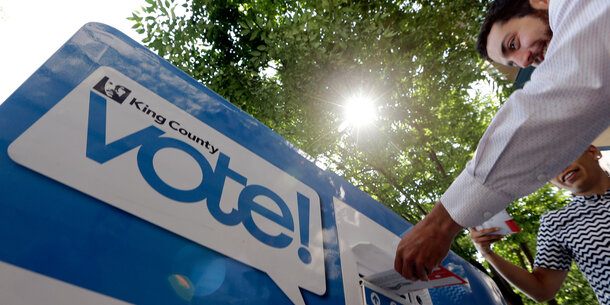In recent publications, Professor Richard Pildes, a leading scholar of the law of democracy, tries to temper the enthusiasm of campaign finance reformers for small-donor public financing. He mistakenly argues that small donors especially prefer ideologically extreme candidates, and so programs that match small donations with public funds, like the one passed by the U.S. House in 2019, will worsen the polarization of American politics. On the contrary, there is good evidence that small donors are not more polarized than others who give to campaigns. And we don’t have to guess whether small donor public financing will increase polarization. Programs that have been in effect for many years have not done so.
All donors, great and small, tend to have partisan preferences. But in the post-Citizens United system, a small handful of megadonors increasingly overshadow millions of small donors. In the last decade, an era of mounting polarization, the total share of election spending coming from megadonors who gave $100,000 or more steadily increased; they contributed the majority of federal election funding in 2016. In contrast, the total share of money coming from small donors has declined.
Empowering these millions of small donors who, unlike the super wealthy, come from all walks of life is the best way to address today’s soaring dominance of wealthy interests. While the polarization of politics is certainly a pressing concern, public financing would not make it worse. In fact, matching small donations is the best solution for a problem that is at least as grave a threat to our democracy: the outsized ability of the very wealthiest interests to influence government policy through massive election spending.
Small donors aren’t more polarized than big donors.
Although Pildes offers anecdotal examples of candidates at one or the other end of the ideological spectrum who have had success with small donors, he also acknowledges that there are other ways to attract small money. Any notoriety can be good for fundraising. Candidates with name recognition, or those in close contests that are being watched, will do well. Steve Scalise (R-LA) attracted large numbers of small donors not because of his ideology, but because of news coverage of him getting shot. Former President Obama proved the power of pursuing small donors in 2008 with a unifying centrist message. Many of the most successful small dollar fundraisers in the current crop of new House members are also centrists with compelling life stories. If they have any defining characteristic, it is that they are the members most likely to face competitive reelection races.
Of course, Pildes does not rely only on anecdotes. But most of the studies he cites did not actually find small donors to be more polarized than large ones, and at least one came to the opposite conclusion.
Two studies Pildes leaves out find that small donors are not more ideological than big donors. An examination of congressional candidates in 2012 found that party leadership and being in close elections targeted by national organizations, in addition to ideology, explained small donor success. And “the top 5% of all incumbents in small-donor receipts (i.e., the 28 incumbents above $250,000) were randomly distributed within their own parties ideologically.” A study of 2008 survey data found that “major donors (giving excess of US$200) appear somewhat more ideological than small donors.”
To be sure, one of Pildes’s sources finds that both large and small donors cluster at the ends of the ideological spectrum, with small donors (defined as giving $500 or less) somewhat more ideological than the top 0.01 percent of donors.
But other studies Pildes points to do not support his argument. One, in fact, stands for the exact opposite position: a set of surveys conducted by the Campaign Finance Institute from state elections in 2006 found that “the policy views and priorities of small donors sometimes correspond more closely with those who give no money than do the views and priorities of large donors.” The authors mused that “bringing more small donors into the campaign finance system could improve the representative quality of the donor pool.”
Another source finds that individual donors are more polarizing than PACs but says nothing about small donors. In fact, it concludes: “Higher individual limits lead to more ideologically extreme legislators holding office,” implying that larger individual contributions are polarizing. As for the idea that PAC money is less polarizing than individual contributions (whether large or small), that ignores the fact that business PAC money is always pro-business. PACs may not choose a side in the culture wars, but they consistently prefer their industry’s profits to regulation in the public interest.
Finally, Pildes cites an article that seems to offer mixed findings based on donations to congressional candidates from 2006 to 2010. It concludes that more small donors would help democratize campaign funding since they come from all income levels, and competitive races tend to see a lot of small donations. It also finds that “the most ideologically extreme incumbents raise more small contributions.” But the fact that certain candidates do well with small donors doesn’t tell us what all the millions of other small donors — and potential new small donors — will do. As noted, extremism is one way to raise small donations, but it’s not the only way; small donors have shown enthusiasm for moderates over and over.
Where it’s in effect, small donor public financing has not increased polarization.
Given that there is little evidence that small donors are more polarized than big ones, it should come as no surprise that, contrary to Pildes’s critique, longstanding small donor matching programs in places like New York City and Los Angeles have not exacerbated polarization. The same goes for the presidential public financing system, which used matching funds in the primaries. For decades, mainstream candidates like Ronald Reagan, George H.W. Bush, Bob Dole, and Bill Clinton won their party’s nomination while relying on the small donor match.
If anything, matching fund programs are likely to reduce polarization by encouraging candidates of all kinds to seek new donors, many living in their own districts. The program in New York City has brought more diverse and more demographically representative donors into political participation. Publicly financed city council candidates in New York City rely more on contributions from within their own districts than other candidates, even though the match applies to donations from people that live anywhere in the city. In other words, rather than appealing to ideologically extreme donors from across the city, public financing has encouraged elected leaders to rely more on ordinary constituents to fund their campaigns.
Public matching is the powerful reform we need because it will empower candidates to rely on their constituents.
Not only will small donor public financing not make polarization worse, it is the most effective solution to a problem just as worrisome as polarization: the consolidation of election funding by wealthy interests. Since Citizens United, the influence of wealthy donors has continued to skyrocket. In 2016, just 400 donors of more than $1 million each gave $1.5 billion, 31% of the cost of the whole election. That’s more than at least 5 million small donors, who together accounted for only 21%. Matching small donations gives candidates the choice to run people-powered campaigns instead of making promises to big donors.
Pildes doesn’t necessarily oppose public financing; he writes that systems that replace private fundraising altogether with block grants of public funds have benefits “without the downsides” of small donor matching. But matching has several advantages over block grants. For one, it increases the representative connection between elected officials and constituents by rewarding retail fundraising: candidates don’t simply stop fundraising as they do under block grant systems, but they fundraise by talking to voters instead of hosting ritzy dinners.
Matching systems also calibrate public funds better than block grant systems, where every candidate gets the same amount, regardless of how competitive or expensive their race is. Possibly due to concerns about being outspent by big money, candidates in recent years have been more likely to opt out of block grant systems in some of the elections where they are available. Participation in matching systems like New York City’s remains high.
In a world of unpredictable outside spending, small donor matching systems put dollars where they’re needed because candidates can work harder for public funds by earning more matchable small donations. And candidates are allowed to keep raising private dollars if they need to, even if they have received the maximum available amount of public funds. The system as a whole empowers the voters and candidates left out by the dizzying heights of big donor spending under the status quo.
The best way to respond to the radical imbalance in election funding we see today is to use matching funds to empower regular people to have more of a voice, which will allow candidates to run competitive campaigns without chasing wealthy special interests.


